中西孝文化差异论文
讨论中国与西方孝作文

讨论中国与西方孝作文因为文化差异的原因,中西孝文化在政治功能上、经济根源上和法律表现上存在着诸多不同,都是伴随着家庭的产生而开始出现的,而且在社会发展中不断发展,甚至相互交融。
中国孝文化有着重要的政治内涵。
“孝”本是规范家庭内部亲子关系的伦理道德,主要指子女对父母的道德义务,是家庭伦理的范畴之一。
但传统的中国社会是家国同构、君父同伦,正如孔子所言“君君、臣臣、父父、子子”,“孝”也就具有了重要的政治意义。
“普天之下莫非王土,率土之宾莫非王臣。
”君为天下父,行孝道就是行忠道,忠孝是一体的。
在统治者看来,忠孝观念是每个社会成员必须遵守的规范。
无论家与国,其权力配置都是严格的父家长制,而皇帝通常被称为君父,皇帝派遣的官吏、地方行政官员则被视为老百姓的“父母官”。
“以孝治天下”成了历代君王成功施政的经验总结。
可见,在传统的中国社会,孝文化不仅仅局限于单纯地敬养父母,已经明显地扩展和泛化了。
《孝经?开宗明义》认为:“身体发肤,受之父母,不敢毁伤,孝之始也;立身行道,扬名于后世,以显父母,孝之终也。
夫孝,始于事亲,中于事君,终于立身。
”孝敬父母只是孝的开始,进德修业才是孝之终。
这与儒家伦理“修身、齐家、治国、平天下”的思想相一致,与儒家“身—家—国”的模式相统一。
可见,“孝”已经同时向个体道德领域和政治领域扩展,它起源于个体道德修养,贯穿于家庭中赡养父母和家庭和睦,终于进德修业,对国家和社会履行职责。
而西方历史上,不仅没有把“孝廉”作为人才选拔的要求,也很少有政府或统治者会公开宣扬“孝道”,甚至在讲求法治的西方社会中,大多数国家甚至对于“子女必须抚养父母”都没有硬性的法律要求。
现在,大多数西方国家也加强了对老年人的优抚,大多通过政策优惠如住房优惠,养老保险等来保障老年人权益。
中国传统的农耕文化与小农经济,造就了她复杂的等级社会,强调个体对社会、对他人的责任,强调人与人之间相互关心和相互爱护,以集体利益为重,“孝文化”也就随之发展逐渐“积厚”。
中西方孝道差异英语文献

中西方孝道差异英语文献孝道是东方文化中非常重要的价值观念,被视为子女对父母的尊敬和孝顺。
在中国传统文化中,孝道被视为人们的基本道德准则,被视为一种伦理操守和社会责任。
而在西方文化中,虽然也有尊敬长辈的价值观念,但孝道并不像东方文化中那样被强调。
在西方文献中,对中西方孝道差异的讨论也一直存在。
在西方文献中,有一些研究探讨了中西方孝道差异的原因。
其中一种观点认为,中西方文化的根本差异导致了孝道观念的不同。
东方文化强调家庭和社会的连结,重视传统和家族的延续,因此孝道一直被视为非常重要的道德准则。
而在西方文化中,个人主义和自由的价值观念更为突出,人们更注重个体的独立和自主,因此孝道并没有在西方社会中得到同样的重视。
另外,一些文献还提到了中西方孝道观念在行为表现上的不同。
在东方文化中,孝道主要通过尊敬长辈、关心家人、尽孝于父母等方式来体现。
而在西方文化中,虽然也有尊敬长辈和关心家人的行为,但这些行为并不像东方文化中那样被视为绝对的道德准则。
西方人更注重个体的自主和自由,他们认为每个人都有权利做出自己的选择,而不必受到传统的束缚。
除了行为表现上的差异,中西方文献中还有一些研究探讨了孝道观念在社会发展和文化传承中的作用。
一些研究指出,孝道观念在东方文化中扮演着重要的角色,有助于维系家庭和社会的和谐。
而在西方文化中,尽管没有像东方文化那样强调孝道,但西方社会仍然有其他的价值观念和道德准则来维系社会秩序。
综上所述,中西方孝道在文化观念、行为表现和社会作用上存在着差异。
这种差异既体现了不同文化间的多样性,也反映了人类在社会发展和文化传承中的不同选择。
无论是中西方文化,孝道观念都是人们价值观念中重要的一部分,它们在不同文化中的表现形式或许不同,但都体现了人们对家庭、社会和人际关系的重视和关怀。
东方人的孝与西方人的孝作文

东方人的孝与西方人的孝作文中西方的孝文化最初都是伴随着家庭的产生而开始出现的。
两千年前,当孔子在夜灯下侃侃而谈“孝为仁之本”时,地球另一边的天主圣徒们正苦心撰写着与孝有关的西方宝典《圣经》。
在东方也好西方也罢,孝,作为家庭生活的连接纽带,几乎有着同样深远的历史。
但是不得不提的是,很明显,中西方的孝文化的发展势头似乎差得越来越远。
作为东方“羊式”文明的发源,中华民族将孝看的跟自己的历史一样重要。
孝,在中国可谓是历史深远,影响浩大,地位丝毫不逊于中国人民餐桌上的水稻和粟。
东方的孝,其实跟顺只是字面上的区别,抛弃外表,它们两个无论是离远了看还是离近了看,其实都差不多。
中国自儒家开始,就向来喜欢宣传孝道。
曾子对这个字曾认为是尊亲,弗辱,能养。
孔子就比他简洁:“无违”。
可见儒家所提倡的“孝”从本质上来说,与服从尊长没有什么差别。
这倒让人不难联想到中国中央集权的统治政体自古呼喊的“爱祖国,爱人民”的象征性。
与儒家“身—家—国”的模式相统一,孝道,将个人与小家紧紧联系在一起,小家又被氏族联系,环环相扣,最终“孝”的作用对一个国家来说可远比仁义道德大得多。
孝的社会意义在于维持一种社会和谐,即对长者和统治秩序的敬畏和基于敬畏的服从。
这是用道德手段巩固统治,中国人向来喜欢从心灵上捆绑行为,调教行为。
就如同中国试图用仁义礼智信来禁止人们偷盗的同时,西方人研究出了监控器一样。
这种文化,它起源于个人,联系着父母亲族,最终汇聚在国家的长河里。
孝,对于东方农耕文明的发展团结起了难以估量的作用。
有趣的是,除了圣经以外,浩荡的西方文化典籍中对于孝的记载简直少得凤毛麟角,这与中国恰好相反。
相对于自己养老,西方人似乎更倾向于把父母交给社会。
西方的孝文化也没有多少社会意义,而其家庭意义仅表现为对父母的尊敬。
这种尊敬也并有导致对父母的服从,而是更多地强调独立,强调家庭成员之间彼此平等。
这导致了西方的孝文化发展缓慢,但却使社会养老理论得到了充分发展。
浅析中西方孝文化

浅析中西方孝文化中西方的孝文化都是伴随着家庭的产生而开始出现的。
由于中西方家庭产生的不同步性,中西方孝文化也不是同时出现的,但最初形态的孝文化却是一样的,即善待长辈。
而随着历史的发展,中西方孝文化也有着较大的差异。
一、中西方孝文化比较(一)中国孝文化中华民族的孝文化历史悠久,源远流长。
在中国五千年灿烂辉煌的文明记载中,中华民族的传统美德涉及方方面面,内容极其丰富,其中“孝”不仅是家庭观念中孝敬父母的问题,也是几千年来统治秩序中重要的社会规范。
中华民族有着一整套关于孝的理论。
中国历史上,“孝”是进入家庭观念中最早的伦理道德范畴。
孝文化在中国文化中有着举足轻重的地位。
孔子提出了“孝为仁之本”,而儒家思想也就是以“仁”为中心的道德思想,可见“孝”在儒家思想中的重要地位。
在《孝经》中,“孝”被置于道德规范的最高地位,“孝者,德之本也,教之所由生也”,意思说,孝是道德的根本,一切教化都从此产生。
同时,《孝经》还认为:“夫孝,天之经也,地之义也,民之行也。
”就是说,“孝”是天经地义的事,是人民固有的自然的行为。
“孝”,作为中华民族传统道德的本位,可以说是一切传统道德规范的核心。
中国孝文化对“孝”有明确的规定,并强调“孝”与“顺”的一致。
曾子认为:“孝有三,大孝尊亲,其次弗辱,其下能养。
”“尊亲”不仅指尊敬,更有一系列礼仪规定;“弗辱”就是要安分守己,不许玷污祖上的名声和家族的尊严,还要珍爱父母给予的身体;“能养”并非一般的供养,而是敬养。
在中国的孝文化中,还强调“顺”,即顺从父母的意愿,孔子对孝的简洁解释是“无违”,儒家所提倡的“孝”从本质上来说,就是服从长上的意志。
中国孝文化有着重要的政治内涵。
“孝”本是规范家庭内部亲子关系的伦理道德,主要指子女对父母的道德义务,是家庭伦理的范畴之一。
中西孝文化差异论文

中西方孝文化的差异孝道是一种道德现象,它以家庭组织之中的血缘亲情为基础,然而又超出于一般意义上的亲子感情之上。
同其他任何一种文化现象一样,孝道乃是众多文化因素共同作用的结果。
由于文化的发展,今天的社会同过去相比,当然不可同日而语。
虽然传统的孝文化在现代社会中有许多不适,但是,尽管时代变了,社会生产方式和经济基础变了,中华民族对老年人的尊敬赡养这种人道主义精神的优良传统,是不能割断的。
无论在任何社会,如果对年老体弱、丧失劳动能力的老人不关心、不赡养,都势必造成严重的社会问题。
对于老年人的尊重与爱护,既可以说是文明社会的重要标志之一,更应该成为现代人的一种社会美德。
由于中西文化的差异,中西孝道也存在不少差异,通过比较可以使我们更清楚地认识孝道的本质,以利取长补短,促进中国孝文化朝健康的方向发展。
一、中西方孝文化比较(一)中国孝文化中华民族的孝文化历史悠久,中华民族的传统美德涉及方方面面,内容极其丰富,其中“孝”不仅是家庭观念中孝敬父母的问题,也是几千年来统治秩序中重要的社会规范。
中国历史上,“孝”是进入家庭观念中最早的伦理道德范畴。
孝当产生或大兴于周代,其初始意指尊祖敬宗、报本返初和生儿育女、延续生命,至孔子,使孝从其宗教与哲学意义转化为“善事父母”的纯粹伦理意义,从宗族道德转化为家族道德,至《孝经》,孝这个反映家庭亲子关系的道德观念被全面政治化了。
中华民族有着一整套关于孝的理论。
①孝文化在中国文化中有着举足轻重的地位。
孔子提出了“孝为仁之本”,而儒家思想就是以“仁”为中心的道德思想,可见“孝”在儒家思想中的重要地位。
孝,作为中华民族传统道德的本位,可以说是一切传统道德规范的核心。
中国孝文化对孝有明确的规定,并强调孝与顺的一致。
在中国的孝文化中,还强调“顺”,即顺从父母的意愿,孔子对孝的简洁解释是“无违”,儒家所提倡的“孝”从本质上说来,就是服从长上的意志。
②中国孝文化有着重要的政治内涵。
“孝”本是规范家庭内部亲子关系的伦理道德,主要指子女对父母的道德义务,是家庭伦理的范畴之一。
东西方文化差异对待老人的英语作文

东西方文化差异对待老人的英语作文Differences in Treatment of the Elderly Between Eastern and Western CulturesIntroductionThe treatment of the elderly in different cultures can vary significantly, and this is particularly evident in the differences between Eastern and Western cultures. In this essay, we will explore the various ways in which the elderly are treated in Eastern and Western societies, and how these differences are shaped by cultural norms and values.Respect for the Elderly in Eastern CulturesIn many Eastern cultures, such as those in China, Japan, and India, there is a strong emphasis on respecting and honoring the elderly. The elderly are seen as sources of wisdom and experience, and they are often revered for their knowledge and insights. In these cultures, it is common for younger generations to show deference to the elderly, and to seek their guidance and advice in important matters.Filial Piety in Eastern CulturesOne of the key values in many Eastern cultures is filial piety, which is the concept of showing respect and deference to one's parents and elders. This idea is deeply ingrained in many Eastern societies, and it influences the way in which the elderly are treated. In countries such as China and Japan, it is considered a moral obligation for children to care for their elderly parents and grandparents, and to ensure that they are well taken care of in their old age.Family Support in Eastern CulturesIn many Eastern cultures, the family unit is seen as the cornerstone of society, and family members are expected to support and care for one another, especially in times of need. This sense of familial responsibility extends to the elderly, who are often cared for by their children and grandchildren in their old age. In many Eastern cultures, it is uncommon for the elderly to live in nursing homes or assisted living facilities, as families prefer to keep their elderly relatives at home and care for them themselves.Treatment of the Elderly in Western CulturesIn contrast to Eastern cultures, the treatment of the elderly in Western societies can vary significantly. While there is certainly a great deal of respect for the elderly in Western cultures, the wayin which the elderly are treated is often influenced by individualistic values and the importance of personal autonomy.Independence and Autonomy in Western CulturesIn many Western cultures, there is a strong emphasis on independence and autonomy, and this can influence the way in which the elderly are treated. In countries such as the United States and the United Kingdom, it is common for elderly people to live independently or in assisted living facilities, rather than with their families. This emphasis on personal independence can sometimes lead to a more individualistic approach to caring for the elderly, with elderly people often encouraged to make their own decisions about their care and living arrangements.Elderly Care Services in Western CulturesIn Western cultures, there is a wide range of services available to support the elderly, including nursing homes, assisted living facilities, and home healthcare services. These services can provide valuable support for elderly people who may not have family members available to care for them, or who require specialized medical care or assistance with daily activities. In Western societies, it is common for elderly people to receive care from trained professionals, rather than relying solely on their families for support.ConclusionIn conclusion, the treatment of the elderly in Eastern and Western cultures can vary significantly, with each culture having its own unique values and norms that influence the way in which the elderly are treated. While Eastern cultures often place a strong emphasis on respect, filial piety, and family support for the elderly, Western cultures tend to prioritize independence, autonomy, and the availability of professional elderly care services. By understanding these differences in treatment of the elderly, we can gain a greater appreciation for the diversity of cultural attitudes towards aging and the elderly.。
浅谈中西方孝文化
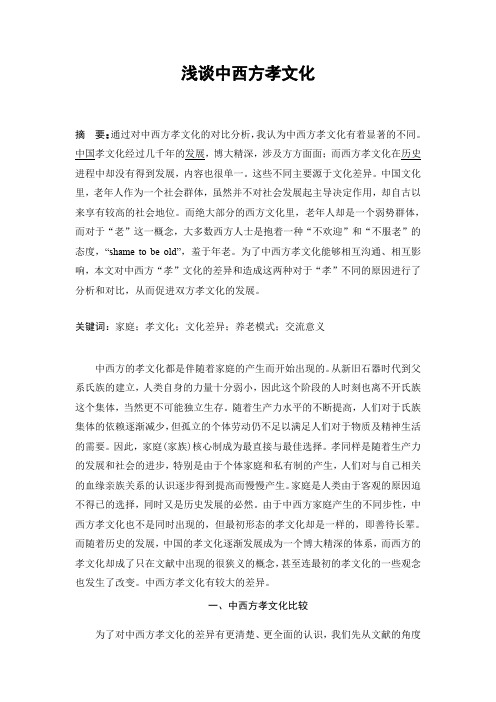
浅谈中西方孝文化摘要:通过对中西方孝文化的对比分析,我认为中西方孝文化有着显著的不同。
中国孝文化经过几千年的发展,博大精深,涉及方方面面;而西方孝文化在历史进程中却没有得到发展,内容也很单一。
这些不同主要源于文化差异。
中国文化里,老年人作为一个社会群体,虽然并不对社会发展起主导决定作用,却自古以来享有较高的社会地位。
而绝大部分的西方文化里,老年人却是一个弱势群体,而对于“老”这一概念,大多数西方人士是抱着一种“不欢迎”和“不服老”的态度,“shame to be old”,羞于年老。
为了中西方孝文化能够相互沟通、相互影响,本文对中西方“孝”文化的差异和造成这两种对于“孝”不同的原因进行了分析和对比,从而促进双方孝文化的发展。
关键词:家庭;孝文化;文化差异;养老模式;交流意义中西方的孝文化都是伴随着家庭的产生而开始出现的。
从新旧石器时代到父系氏族的建立,人类自身的力量十分弱小,因此这个阶段的人时刻也离不开氏族这个集体,当然更不可能独立生存。
随着生产力水平的不断提高,人们对于氏族集体的依赖逐渐减少,但孤立的个体劳动仍不足以满足人们对于物质及精神生活的需要。
因此,家庭(家族)核心制成为最直接与最佳选择。
孝同样是随着生产力的发展和社会的进步,特别是由于个体家庭和私有制的产生,人们对与自己相关的血缘亲族关系的认识逐步得到提高而慢慢产生。
家庭是人类由于客观的原因迫不得已的选择,同时又是历史发展的必然。
由于中西方家庭产生的不同步性,中西方孝文化也不是同时出现的,但最初形态的孝文化却是一样的,即善待长辈。
而随着历史的发展,中国的孝文化逐渐发展成为一个博大精深的体系,而西方的孝文化却成了只在文献中出现的很狭义的概念,甚至连最初的孝文化的一些观念也发生了改变。
中西方孝文化有较大的差异。
一、中西方孝文化比较为了对中西方孝文化的差异有更清楚、更全面的认识,我们先从文献的角度对中西方的孝文化进行考证研究,然后在此基础上对中西方孝文化进行对比分析。
浅谈中西方孝文化差异

海南大学跨文化交际导论论文题目:浅谈中西方孝文化差异作者:学号:学院:专业:时间:目录摘要 (3)关键词 (3)正文 (4)参考文献 (6)摘要孝作为人类社会一个最基本的伦理行为之一,在中西方存在着巨大差异。
本文从中西方关于孝的不同理解来阐述中西方孝文化的差异。
将两者进行比较,进而互相学习,丰富各自的孝文化.关键字:中西方文化孝差异众所周知,中西方文化存在着巨大差异,这些差异在伦理观上表现更为明显.孝作为人类社会一个最基本的伦理行为之一,在中西方同样存在着巨大差异。
一、中国孝文化华夏传承久远,华夏民族传统美德极其丰富,“孝”文化亦在其列。
“孝" 在上古时期就进入伦理道德范畴。
最早可溯自周,本意是崇祖拜宗,念本及报生养之恩之意。
而对孝文化充实发展的则是儒家的孝道理论。
孔子及其后学子将孝观念系统化、理论化,直至形成孝的专著《孝经》。
儒家孝理论奠定了中国传统孝文化的基础,逐渐成为一种普遍的伦理原则和治世之道。
“孝”于家庭为后代对双亲的道德义务。
于掌权者,忠孝为所有社会个体必守规范。
如西汉提出“以孝治天下”的口号,东汉的“三纲五常”道德体系。
由此可知,在国内,孝义不仅仅是敬养双亲,还有显著的延伸与泛化.二、西方孝文化对比于中国孝文化的悠久传统,西方则相对薄弱.西方孝文化来源有三:一为古希腊文明;二为犹太文明;三为古罗马文明。
它们融合后以基督教的形式构成西方文明。
因此探寻西方孝文化得先对《圣经》进行研究,其被认为是欧美文学艺术灵感源泉,西方很多的道德理论亦来源于它。
据《圣经》记载,基督徒造物主定下十戒律,第五条即为“孝敬双亲”。
对中外孝文化比较,除《圣经》外,西方对“孝"理论系统描述的很少,这与我国反差巨大。
三、中西方孝文化比较1、“孝顺”概念中国的孝强调“孝顺"这个概念,强调对父母的顺从,但并非盲目的顺从.西方人则基本没有“孝顺”概念。
他们强调独立、平等.在他们看来,中国的“孝顺”更多的是单方面的义务.单一地强调子女对父母的敬重,在西方人看来是无法理解的。
浅谈中西方孝文化差异.doc

浅谈中西方孝文化差异.doc
孝是一种普遍存在于不同文化中的道德观念,它强调对父母的尊敬、照顾和关爱。
虽然东西方的孝有相似之处,但也有一些区别。
1.在中国文化中,孝是非常重要的价值观念,它被视为“修身、齐家、治国、平天下”的基础。
在中国传统家庭中,孩子们通常会以尊敬、照顾和关爱父母为荣,并将孝行看作是他们的义务和责任。
尊重父母不仅体现在言语上,还体现在行为上,包括为父母做饭、打扫卫生、照顾生病的父母等。
孝顺父母被认为是一个人修身成德的必要条件,也是社会和谐稳定的基础之一。
2.在西方文化中,尊重父母也是一个重要的价值观念,但孝并不像在中国那样强调。
在西方文化中,父母更多的是被视为朋友和顾问,而孩子们的义务不是像在中国那样追求孝顺和顺从,而是尊重和信任他们的父母,并在他们需要帮助和支持的时候给予帮助和支持。
总的来说,东方文化中的孝强调子女应该为父母做任何事情,无论是行动上还是言语上,而西方文化中的孝强调尊重和信任父母,并为他们提供必要的支持和帮助。
这些文化差异反映了东方和西方在家庭关系、道德观念和社会价值观念等方面的不同。
中西方孝文化之比较

中西方孝文化之比较百善孝为先。
自古以来中国就是一个提倡要尊老爱幼,善待老人的国家。
而在西方文化中,老年人是一个相对弱势的群体,对于老年人抱有一种不欢迎甚至讨厌的态度。
分析比较其中西方孝文化的差异,对于中西方孝文化的交流与发展和社会的和谐安定均具有重要的指导意义。
标签:中国孝文化;西方孝文化;比较一、中国孝文化发展概况孝文化是在长期的历史发展进程中形成的,大致经历了孝行、孝德、孝道、孝治四个阶段。
夏商时期,有关孝行的记载,则可以追溯到新时期晚期的舜。
根据记载,舜在幼年的时候丧子,后母又带来一子。
舜的父母与弟弟性格怪戾、偏激,他们多次加害于舜,欲除之而后快。
但是舜依然孝心不变,用真诚的孝行使家庭归于和谐。
西周时期,发生了巨大的变化,孝对于每个人而言,是人人必须具备的品德。
整个社会都在歌颂孝,从后来传下来的文献中我们不难看出。
《诗经》中歌颂孝行的文章,风、雅、颂屡见不鲜。
如《周颂·载见》说“率见昭考,以孝以享”,像这样的很多种铭文,在青铜器上都有记载。
东周时期,孝文化因为春秋时期天下大乱,礼乐制度崩坏,为了权与利,子女可以杀死自己的父亲,弟弟可以斩杀自己的兄长,毫无人伦可言。
就是在这个混乱的时代,人们对孝却有了更为深刻的认识,并对于孝进行了反复的讨论、交流,最终形成为一种理论,是成为“孝道”。
汉魏和以后历朝,孝文化始于汉初,在魏晋时期得到了强化,在唐宋时期已经比较成熟,并一直延续到明清。
在汉代时采取董仲舒的建议,独尊儒学,《孝经》成为全社会最基础的读物。
魏晋南北朝时是《孝经》倡行于全社会,几乎所有人都在学习。
唐朝是孝治的成熟时代,而唐以后的朝代,在更大、更深的领域推广之。
到了明清时期,又出现了新的规定与政策。
为了鼓励整个大家族在一块居住,凡在一块居住达三五世以上,政府授予“义门”称号。
对于奉孝老人者,还给予褒奖。
二、西方孝文化发展概况西方文化大都以基督教的形式表现出来,因此,《圣经》是研究西方孝文化的法宝,道德规则也是出自于此。
从孝文化看中西方文化差异-最新文档

从孝文化看中西方文化差异孝文化是中华民族享誉世界的精神文化瑰宝之一。
随着历史的变迁与发展,孝文化的内涵已深深的烙印在人们的意识中。
“孝”观念不仅仅意味着孝敬父母,尊敬长者,同时在古时期还与社会等级、政治体系等有着密不可分的关系。
然而,在现代化进程不断加速的今天,宝贵的孝文化似乎已被人们抛在了脑后,遗弃、虐待老人的事迹屡屡发生在我们眼前,重塑孝文化已变得刻不容缓。
另一方面,在多元化的世界格局之下,中外交流互动逐渐深入,打开了历史新局面。
因此,孝文化的交流也不例外。
本文从将从中西方孝文化渊源、概念着手深入讨论孝观念的差异,并延伸至导致这一差异的原因分析,剖析中西方文化根源的异同。
1、中西方孝文化概述中国传统文化几乎涵盖了我们现今社会的方方面面,而孝文化则是我们追溯有关家庭伦理价值观的最早记录。
其深远的历史起源以及丰富的内涵是其他诸多文明国家所不能比拟的。
孝文化概念起源于公元前11世纪,在周朝明确提出。
在当时祭祀活动盛行的社会文化背景下,“孝”指的就是通过祭祀活动表达对祖先的敬意,祈求祖先保佑自己在农业生产中以及与大自然的对抗中一帆风顺、丰衣足食,不包含任何道德的涵义。
直至西周时期,“孝”被赋予了道德涵义,商朝普遍的祭祀活动成为了贵族的特权,而普通百姓有了必须侍奉双亲的义务。
于是,侍奉双亲的“孝”逐渐取代了祭祀仪式的“孝”。
在春秋战国时期,孔子作为儒家文化的创始人将孝文化再次拉升到一个高度,自此,孝道成为古代社会宗法伦理的基础。
到了汉代,皇权社会将“孝”的涵义政治化,孝道开始成为了治国安邦的准则:西汉时期颁布多道法令以孝治国;《孝经》被作为义务教育科目之一;“孝廉”作为察举考试科目之一等等。
中国传统孝文化的内涵丰富,人们通常理解的孝敬父母只是其中很小的一部分。
在儒家文化中,“孝”不仅仅是指尊重父母敬重祖先,它更是人类的行为准则,是国家政权的基石。
也就是说,孝文化除了在家庭伦理文化中有所体现,如赡养父母、继承子嗣等等,其政治内涵也颇为丰富。
传统道德与现代理念的碰撞——中西方孝文化差异

传统道德与现代理念的碰撞——中西方孝文化差异传统道德与现代理念的碰撞——中西方孝文化差异俗话说“百善孝为先”,在世界文化日益融合的今天,我们看到了文化与文化的趋同与差异,而孝文化是文化差异的重要组成部分之一。
中国的孝文化源远流长,从古至今,已经发展成为了一种博大精深的体系,并且在某种程度上成为了衡量一个人品质的标准。
而西方的孝文化并没有太多系统的描述,与中方形成了强烈的对比,西方似乎更崇尚个人与自由。
本文将探析中西方孝文化概念和发展的差异,并以这几年的热门话题——“安乐死”来进一步阐述中西方在孝文化上的差异。
孝,是随着社会进步,人们对于血缘亲情的认识而慢慢发展起来的。
家庭,是体现孝道的人类社会的选择,也是一种历史发展的必然产物。
孝道是道德表现一种形式,居于普通亲情之上,一般体现在直系亲属之间,所以我们现在所谓的尽孝道,一般都是自己的父母。
随着社会经济的发展,尽孝道的方式产生了很多变化,但是赡养义务的传统却从来不曾割断。
在社会层面上,尽孝道则主要是指对老人的尊敬。
因为文化不同,中西方对孝道的理解差异很大,但不可否认,中西方的孝文化都是伴随着家庭的产生而开始出现的,最初形态的孝文化也是相似的。
而随着时代的发展,中国的孝文化已经成为了一个博大精深的体系,而西方的孝文化还是停留在浅显的文献描述之上。
1中西孝文化对比 1.1中国孝文化孝是中华民族的传统美德,孝文化是中国传统文化最突出的特色。
“孝”不仅是家庭观念中孝敬父母的问题,也是几千年来统治秩序中重要的社会规范。
我国的孝观念形成于父系氏族公社时代。
孝文化,在股商时期便已产生。
[1]在中国,尽孝讲究的是到达亲人在精神层面的满足。
孝意味着养,但不是养了就是尽孝道,子女赡养父母,最重要的是要有孝心,是一种血浓于水的亲情的体现,而不是仅仅有孝行。
孝文化在我国的儒家思想中有着极其重要的地位,孔子在《孝经》中曾写到:“父子之道,天性也。
”[2]就是说,父母养育子女和子女赡养父母,是人类社会发展的一种天性。
中美孝文化对比论文

A Comparative Analysis of Chinese and American FilialPiety CulturesSchool of Foreign Languages, CWNU, Nanchong, China, 637002Abstract: It is important for us to know the differences of filial piety cultures between China and America in cross-culture communication. This paper focuses on the differences between the two countries' cultures of filial piety and analyses the reasons for these differences which are different in the aspects of cultural origination,social values and old-age insurance system. From the comparative analysis, we can have a good knowledge of the two countries' filial piety cultures and learn each other's advantages to facilitate the harmonious development of our filial piety culture. Key Words: Filial Piety, Obedience, Cultural Difference, Reasons.I IntroductionFilial Piety, an indispensable component of Chinese traditional cultures, puts more emphasis on the moral responsibilities. It is based on the blood bonds of a family. As a part of traditional cultures in China, filial piety possesses abundant cultural connotations and receives much importance in the long history of China, however, it receives less importance in America. There is no real filial piety in American cultures. Filial piety shows the relationship among family members and social attitudes toward elders. Arthur Henderson Smith( Arthur Henderson Smith:Chinese Characteristics,1991,Page 5-6)said:" Relationships in western families tend to desalinate, so we westerners should pay more attention to Chinese filial piety. Respecting the elder is good general mood of society, but we westerners haven't been changed by it. In western countries, children choose their own way on which they can develop themselves very well, without worrying about their parents. Social habits like this are unnormal in China."Filial piety can be regarded as a primary virtue in Chinese cultures. In the Chinese ancient book The Twenty-four Filial Exemplars, there aremany stories about filial piety, which told us that how the ancient children practised filial piety. In Chinese ancient history, people put much emphasis on it, however, in America, there are few such books on filial piety and it received less emphasis than in China, what's more, America does not have such a strong cultural atmosphere of filial piety as China.The comparison of Chinese and American filial piety culture can reveal the cultural differences and similarities between the two countries in those aspects to help us learn the advantages from each other's culture and have a better communication. In this paper, I use the method of comparative analysis to study the differences and similarities of Chinese and American filial piety cultures. In the first part, I make an introduction of filial piety cultures to have a basic knowledge about it. In the second part, I make literature review, including previous studies on filial piety, definition, classification and social meaning and cultural connotations of filial piety. In the third part, I compare the differences of filial piety cultures between China and America, and I also point out their similarities. In the fourth part, I point out the reasons for their differences. In the last part, I make a conclusion.II Literature ReviewA Previous Studies on Filial PietyThere are many studies and researches on filial piety, such as Filial Piety in Chinese Thought and History wrote by Chan·Alan·Kam-leung and Tan·Sor-hoon(London: RoutledgeCurzon, 2004, Page45-50), Filial Piety Practice and Discourse in Contemporary East Asia wrote by Ikels·Charlotte(Stanford, Calif: Stanford University Press, 2004, Page57-61),The Ways of Filial Piety in Early China wrote by Radice·Thomas(University of Pennsylvania, 2006, Page23-25),and Chinese Filial Piety wrote by Traylor·Kenneth Land(Bloomington: Eastern Press, 1988, Page34-35). The studies are mainly focused on its history and development. They studied the filial piety from the aspects of how filial piety were practised and what role filial piety played in people's behaviours. In this paper, my study is different from the previous stduies.I firstly study the differences of filial piety cultures between China and America,then I analyze the reasons for such differences. My study mainly focus on the differences between the two countries and reasons of cultural origination and old-age insurance system by using the method of comparative analysis, which is the difference between my study and the previous studies.B A Brief View of Filial Piety1 DefinitionIn CiHai(Page 2376), a well-known Chinese lexicon and character dictionary, the definition is "ancient moral standards".In Confucian ideas, we can get the definition is " no disobeying".In Chinese literary outputs, there were many classics and books which gave definition to filial piety. In the book Erh Ya (ancient book containing commentaries on classics, names, etc), the definition was "taking good care of parents is filial piety". In the New Book, written by JiaYi who lived in Han Dynasty, the definition was "chinldrens' loving their parents was filial piety". In addition, in the Ten Commandments of Bible, article v, there is a sentence: "honor your father and mother, that your days may be long in the land which the lord your god gives you", which we can regard it as a definition of filial piety.2 ClassificationIn Chinese classic Book of Rites, Filial Piety has three principles:" firstly, respecting elders; Secondly, no shaming; Finally, being able to support your parents." Filial piety can be divided into many categories. Respecting and honoring elders, loving elders and so on can be regarded as behaviour of filial piety. In the book Filial Piety is Priceless , written by Bi Shumin(a Chinese female literary author, born in 1952), we can know that children should honor and pay filial piety to their parents immediately, if not, they will regret because of the temporality of time and human life. Whatever you do, it is filial piety. Maybe it is a luxurious house or a rubble; Maybe itis a sumptuous feast or a wild flower; Maybe it is a gold or a coin, but on the scale of filial piety, they all have equal values.3 Social Meanings and Cultural ConnotationsFilial piety is Chinese traditional virtues and it was closely related to Confucianism, even it can be seen as the core of Chinese traditional culture. In the long history of China, it plaid an important role in society. Almost all rulers in every dynasty advocated filial piety for the benefit of their ruling, because they were prone to "govern the state by filial piety". We are familiar with such sayings as the "three cardinal guides and the five constant virtues", "Let the king be a king, the minister a minister, the father a father and the son a son". They were conducive to maintain a harmonious ruling orders and establish a cohesive feudal society to enhance imperial power, therefore, the feudal rulers vigorously advocated the ideas of loyalty and filial piety. In ancient times, the rulers extraordinarily put emphasis on candidates' moral virtues when they were choosing feudal officials. In Han Dynasty, the rulers established a system of choosing placemen—recommending people noted for their filial piety and moral records, which primarily judged whether people were filial or loyal. The degree of being filial to their parents is a main factor of whether they could be in that place.In addition to the benefits of the rulers, the common people also advocated filial piety. They particularly paid attention to moral self-cultivation, seeing filial piety as one important part of their moral virtues. When they were young, they should respect their parents. When they grew up and had a family, their parents became old, so they should support their parents. When their parents passed away, they should buried them and be in mouring for three years.III Comparison of the Filial Piety Cultures in China and AmericaA Differences1 General Obedience to Parents and Status EqualityIn China, general obedience are concerned to be one's basic doings if they werefilial to their parents. Parents have a higher status in a family and shows a little patriarchalism. Confucius once gave brief definition that filial piety is "don't disobey your parents", which taught us that what we simply do is to obey our parents. In Chinese ancient claasic book XiaoJing and Analects of Confucius, it pointed out that children should be obedient to their parents unconditionally. If their parents are wrong, children should correct them, but if they don't accept, children should only be obedient and deferential. In addition, children should not disagree with their parents. When it is time to decide a important issue in the family, the power of decision is grasped in the hands of their parents who have the absolute right to decide everything, especially parents always want to decide their children's marriage. It is called "arranged marriage". In ancient times, children can not choose their spouses freely, which was arranged by their parents, therefore, the sayings " dictates of parents and words of matchmakers" was spreaded from dynasty to dynasty, even now, parents have certain effect on their children's marriage. Obedience is that children should not disobey their parents' wishes, what they say, and do according to what they think you should do. There is a traditional saying that "there are three forms of unfilial conducts, of which the worst one is to have no descendants". It explains that children should have a descendant to carry on the Stewart name because every Chinese parents want to have grandchildren in their later years. What's more, our parents are elders and we can't address them disrespectfully by name, including other relatives, which is a reflection of filial piety. We live with the traditional concepts of the proper formalities between young and old and we should obey such a tradition. Therefore, filial piety is concerned as not just as a behaviour but also a sort of affection in Chinese traditional filial piety culture.In America, children are filial to their parents to a certain degree, but mostly they are more focused on the equal status in a family. Children don't need to be submissive to their parents who don't occupy a commanding position. Their relationship is more equal and democratic in the family. American don't have such a strong concept as Chinese. Their children don't have to have descendants and their parents don't exert pressure on their children. Parents and their children even can be friends and they cantalk their inner thoughts and feelings to each other. What's more, children can call elders name directly, especially between strangers, because they consider it embodies equality and democracy,which can not be imagined in China.2Compulsory Tasks for Children and Responsibilities for the Old-age Insurance SystemIn China, parents put children in the most important place and they think that fostering children is their primary task, because China is an agricultural country from the ancient times to now and there is no perfect old-age insure system. The idea that bringing up children for the purpose of being looked after in old age is entrenched in their hearts. Even in today's society, it still has its meanings. They consider children as their whole life, therefore, they are willing to take every expense to raise their children, which can not be imagined and understood by American. Children rely heavily on their parents before they became an adult, so parents bring up them until they get marraried. When parents are at their prime time, they paid everything to raise their children. The only goal of Chinese parents is to bring them up and give a good education to their children. It is really a big burden and project for Chinese parents to raise a child, therefore, it is not strange at all that parents seen their children as their whole life in China .When parents became old and can not do things, now they depend on their children in return, which become a compulsory task for children. Reciprocating for the love and care of their parents' bringing up is a reflection of filial piety. Supporting our parents is regarded as one's moral virtues of filial piety.However, American parents are living a more relaxing and relieved life. In their eyes, children are not necessarily their whole life . They can either choose to have a child or not.If one couple don not have a child in China, they will be treated differently and gossiped by others,however, American parents will not be treated like that. Even American parents choose to have a child or more, they still live better than Chinese parents. Unlike Chinese parents, they do not need to take great expense to raise a child. Children can depend on their parents before being an adult, after which they can only rely on themselves, and parents need not to have the responsibility toprovide money or shelter to them. In return, when children grew up and establish a family, they do not have the compulsory task to support their parents who do not need to bother their children. In America, they have a perfect old-age insure system, American parents do not need their children to support them. When they became old, the only place where they will go is the old folks' home where they can get a better care and service than in China, therefore, the primary burden and task is undertook by government.3 Emphasis on Blood Bonds and Stress on Individual Freedom IndependeceUnder the influence of clan and name cultures, Chinese people put extraordinary emphasis on blood bonds and own a strong concept of family cohesion. From ancient times to now, blood bonds occupy a demanding position between interpersonal relationship. For the traditional concepts of Chinese people, children resume their parents' life. Relatives are connected with each other on basis of blood bonds. Paying attention to blood relationship and kinship is Chinese historical and cultural tradition. The interpersonal relationship in the most stable factors is the blood relationship, so Chinese people believe in "blood is thicker than water " in the traditional sense. Chinese people's family value is particularly strong, thus they advocates the extended family of "four generations living under one roof", and they are content with the "flourishing population and having many children and grandchildren". In a Chinese traditional family, parents have the absolute authority, and maintain the relationship between family members, respecting and honoring elders. The traditional idea that "you should not go on a long journey when your parents are still alive" fully embodies the Chinese traditional family clan concept. In addition, the thoughts of "being sentimentally attached to homeland" and "one wants to return to his home in his old age" is the ideological reflection.American people, on the contrary, put more emphasis on individual freedom and they respect and advocate individual freedom. With such a concept, American people do not hope others intrude into their own space. Unlike in China, when children growup and have a family, no matter how their parents are old, they will not live with their parents together,even they live far away from their parents. Only when it is a festival, a family can get together temporarily. On the Mothers' Day or Fathers' Day, parents can get some gifts from their children. For most American parents, they are very lonely and can not enjoy the happiness of their family when they became old, therefore, American elders are more prone to suffer psychological problems and autism than Chinese elders.B Similarities1 Respect for the EldersRespect for elders is a universal moral virtue of humans. Both in China and America, it is a common sense that we should respect our elders, including other elders. Confucius described old age as a "good and pleasant thing" which caused you to be "gently shouldered off the stage, but given a comfortable front stall as spectator." This honorable sentiment paints a melancholic image of how senior citizens should be treated, given peace in their twilight years while able to freely dispense their wisdom to younger generations.2 Love for ParentsThere is no human being who is unaffectionate. Love for our parents is a great love in the world. When we are children, our parents pay much love to us, and we grow up healthily and happily under their love. When our parents became old, they also need love. No matter he is a Chinese or an American, he should love his parents. Love for our parents is a common love between Chinese and American people.IV Reasons for the DifferencesA Cultural OriginationChinese filial piety idea originated in the patrilineal clan commune period, and the culture of filial piety formed in the Shang Dynasty. Chinese modern filial piety culture mainly originated from Confucian ideas and its classic books. Now Confucianideas is seen as a standard of Chinese traditional moral virtues.American filial piety culture belongs to western cultures which originated from the ancient Greek culture, ancient Hebrew Jewish culture and ancient Rome culture. Bible has always been regarded as the source of western literature and art. Many ethnic standards are also stemmed from Bible. According to the records of Bible, Christians believed in the ten commandments that was issued by Lord God.B Clan-standard and Individual-standard DifferenceThe difference between clan-standard and individual-standard was firstly pointed out by Chen Duxiu. In China, clan makes the standard of action. China is a patriarchal society. A basic trait of this kind of society is that family has the same structure with the country. Every aspect of life is included in the patriarchal system, such as politics economy, morality and education. Rulers ruled the country by ruling clans. In such a society, rulers paid attention to maintaining the peace and harmony of clans. It was not only because stable clans were the basics of a stable country, but also the country was a larger clan society. Filial piety, as the ethic basis of the patriarchal system, played a significant role in maintaining clan's unity and continuance.Western society was separated from clan society completely. It did not stem from patriarchal system like China and had no clannish color in the mind. Western family formed simply. Generally, it was a nuclear family taking the couple as the center. Family members had their own properties. Western families were looser than Chinese families. Western family had no such binding force to its members. Therefore, individual was the standard of their ethical and cultural conception.C Integration and Fraction of Generations DifferenceChinese filial piety culture aims to maintain clan's stability. It stresses inevitable integration of generations. Western culture values men's freedom and equality, so it certainly stresses fraction of generations. The co-called "integration of generations" is a conception that stresses unity and harmony between generations. It isthe basic spirit of filial piety. The "integration" is conservative and unequal. As we mentioned above, filial piety stress the later subordination to elder generations . In ancient China, we could say that there was no "generation gap".Western family is nuclear family in which there are only parents and children. Relations between generations are relatively simple. They need not to be responsible to each other. It is not strange for American people that children lead their own life and parents live in an elder's house. But in China, people may think that it is unreasonable and heretical. Western education emphasize freedom, for example, parents guide children to walk on their own way when they at a very young age. Mr. Fei Xiaotong thought that this kind of love needed repay. He said:“love to children was not free. Children in America understood that when they were very young, parents would't love you because you were their children. Children had no rights to gain love from parents. Love was trophy.D Social Vales: Youth-supreme and Elder-supreme DifferenceAs we know, the youth is supreme in America and the elder in China. Different social and cultural values have different values which result from different choices. America is considered as children's heaven, youth's battlefield and elder's tomb. And China is children's playground, youth's training place, middle age's work-room and elder's kingdom. American anthropologist Xu Langguang said, when he compares the two different life styles between China and America, no country in the world attaches such importance to children as America. Compared with America, unexaggeratedly speaking, China paid less attention to children before 1949. He said that if an American person is proud of so many protect-children associations in his country, Chinese would have the same pride that filial piety is the highest ideal in their ancient national cultural heritage. American anthropologist Margaret Meader put forward the conceptions of "Qianyu culture", "Bingyu culture" and "Houyu culture". "Qianyu culture" means that younger generations learn from elder generations. "Bingyu culture" means the learning of the youth or the elder occurs in the same generation. "Houyu culture" means the elder learn from the youth. In fact, "Qianyu culture" is akind of youth culture. Therefore, people said the Chinese culture was a culture of respecting the elder, while western culture was a culture of paying more attention to the future and the youth's creativity. Certainly, this kind of difference has its own reason., such as natural geographic circumstances, economic patterns and cultural traditions and so on.V ConclusionChinese people are more filial to their parents in the perspectives of ethnic responsibilities and blood bonds; The status of family members in America are more equal and they are less filial to their parents because of the perfect pension system.The filial piety in China puts more emphasis on their children's ethnic responsibilities and the traditional blood bonds; The filial piety in America is shown in the religious cultures, and its pension system is more perfect than that of China.In modern society, Chinese people are facing both traditional filial piety and western conception of relationships between parents and children. What to drop and what to adapt is a problem that many people should think about deeply. At least, we should consider it from two aspects: individuals and society. Individuals should try their best to love and respect the elder so that they can live a happy life in their rest years, and the society should establish "social filial piety" to patch up individuals' loopholes.From the comparative analysis of Chinese and American filial piety cultures, we know that, despite the differences, we can gain advantages from each other in cross-culture communication. Meanwhile, American can learn more about Chinese filial piety culture to give more care to their elders and Chinese learn to give more attention to children.ReferencesArthur Henderson Smith:“Chinese Characteristics”[M]. YanBian City: YanBian University Press, 1991, 5-6.Xu Langguang:“American and Chinese: A contrast between the two lifestyles”[M]. HuaXia Press, 16Aug.1987:17-19.Margaret Meader:“Culture and Commitment—A Research on the Problem of Generation Gap”[M]. HeBei People's Press, 1987,11</wiki/Filial_Piety>涂耀威. 论语中国“孝”的文化内涵[J].孝感学院学报, 5 (2005): 5-8.朴钟锦.儒家“孝”道观念的时代价值[J].北京第二外国语学院学报, 2 (1999): 3- 4. 费孝通. 美国与美国人[M]. 北京:三联书店,1985 :7-8。
中西孝文化差异的原因初探

中西孝文化差异的原因初探摘要:中西孝文化历史悠久,源远流长。
但中国孝文化为统治者利用后,逐步成为中国传统文化的主流而对后世影响深远;西方孝文化却因“孝”的理解不同、个人主义思想、社保制度的建立而没有得到充分的发展。
当今中国社会对中西方孝文化的差异及其原因缺乏充分的认识。
通过本文,笔者叙述了中西方孝文化的历史渊源,分析了中西孝文化的发展差异及其背后原因,从而在中西交流日益频繁的今天提供一定的借鉴作用。
关键词:孝文化;认识误区;差异;儒家;基督教引言孝道是儒家文化的核心价值理念与首要道德。
[1]早在西汉就出现了系统论述孝道理论的《孝经》。
孝文化历经两千多年历史一直传承至今,成为中国传统文化的核心部分。
因而从某种意义上说,传统的中国文化就是孝文化,传统中国社会就是奠定于“孝道”之上的社会。
[2]中国已进入老龄化社会,弘扬孝文化对构建社会主义和谐社会和精神文明建设十分重要。
然而,越来越多的新晋父母肩负着赡养老人和抚养子女的双重义务,经受着“上有老下有小”的尴尬生存现状。
日益频繁的中西文化交流,使越来越多的中国年轻父母羡慕西方人:既不要承担子女成年后的抚养义务,又不要承担父母的养老责任。
明显的文化差异导致有人认为中国孝文化只是一种负担而盲目崇拜西方文化。
这样的认识误区不利于处理家庭关系与构建和谐社会。
梳理中西方孝文化的历史渊源,分析导致两者发展差异的不同原因十分必要。
二、中西孝文化的渊源人类历史有其发展规律,孝文化的产生也不例外。
文化的产生由生产力决定。
在原始社会,无论是在中国还是西方国家,生产力十分低下,个人能力有限,只有团结起来才能创造更多的物质财富、防御外族侵略、抵抗各种自然灾害。
“孝”是随着生产力发展和社会的进步,特别是由于个体家庭和私有制的产生,人们对与自己相关的血缘亲族关系的认识逐步得到提高而慢慢产生的。
[3]父母决定着或决定过家中的物质来源,是或曾是家中的支柱,他们的地位自然而然受到晚辈的敬重。
孝文化论文:探析中西方孝文化之差异及其原因
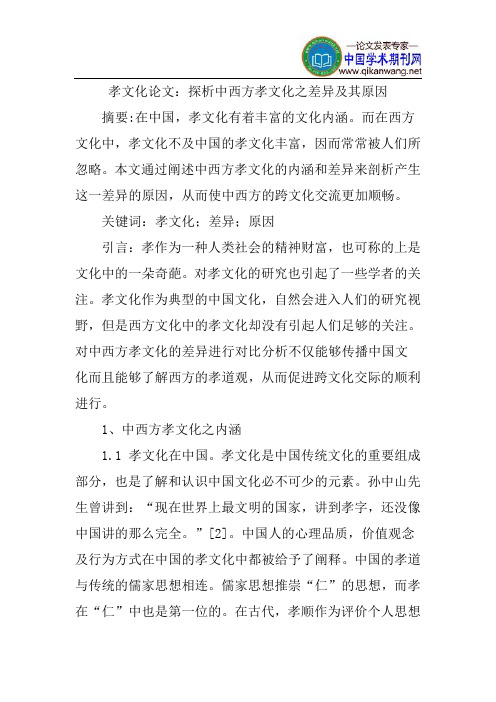
孝文化论文:探析中西方孝文化之差异及其原因摘要:在中国,孝文化有着丰富的文化内涵。
而在西方文化中,孝文化不及中国的孝文化丰富,因而常常被人们所忽略。
本文通过阐述中西方孝文化的内涵和差异来剖析产生这一差异的原因,从而使中西方的跨文化交流更加顺畅。
关键词:孝文化;差异;原因引言:孝作为一种人类社会的精神财富,也可称的上是文化中的一朵奇葩。
对孝文化的研究也引起了一些学者的关注。
孝文化作为典型的中国文化,自然会进入人们的研究视野,但是西方文化中的孝文化却没有引起人们足够的关注。
对中西方孝文化的差异进行对比分析不仅能够传播中国文化而且能够了解西方的孝道观,从而促进跨文化交际的顺利进行。
1、中西方孝文化之内涵1.1 孝文化在中国。
孝文化是中国传统文化的重要组成部分,也是了解和认识中国文化必不可少的元素。
孙中山先生曾讲到:“现在世界上最文明的国家,讲到孝字,还没像中国讲的那么完全。
”[2]。
中国人的心理品质,价值观念及行为方式在中国的孝文化中都被给予了阐释。
中国的孝道与传统的儒家思想相连。
儒家思想推崇“仁”的思想,而孝在“仁”中也是第一位的。
在古代,孝顺作为评价个人思想高尚与否,品行是否端正的重要尺度。
能够说明这一点最好的例子就是中国官制中的举孝廉。
举孝廉是汉代的一种选拔官吏的制度,其中主要考察人们是否孝顺或是清廉。
子女对父母的孝顺程度是能不能为官的重要因素。
除此之外,中国的孝文化突出了长者和老人的地位。
孝文化中的“孝”就是要养老,敬老,尊老,送老,亲老。
[3]晚辈要尊重长辈的意见和安排,承担着对父母的赡养义务。
在家庭中,子女就是父母的私有财产,子女对父母的话要言听计从才能被称之为孝顺。
在家庭范围内的孝文化还包括传宗接代的任务。
个人的孝行的社会意义还表现为对君主的忠心。
在中国传统文化的影响下,君主的地位是至高无上的,作为臣民,尽孝的方式就是听从君主的旨意,替君主排忧解难,完成自己的使命。
1.2 西方的孝文化:西方的文化是以苏格拉底,柏拉图和亚里士多德为代表的古希腊文明和古希伯莱文化为基石的文化。
中西孝亲文化异同作文
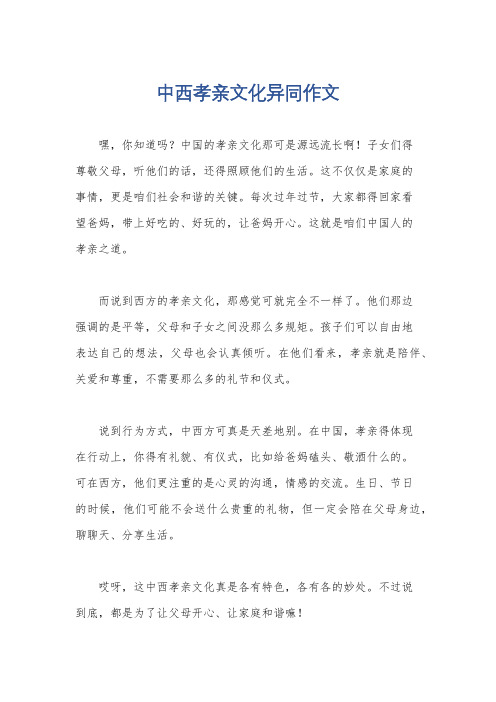
中西孝亲文化异同作文
嘿,你知道吗?中国的孝亲文化那可是源远流长啊!子女们得
尊敬父母,听他们的话,还得照顾他们的生活。
这不仅仅是家庭的
事情,更是咱们社会和谐的关键。
每次过年过节,大家都得回家看
望爸妈,带上好吃的、好玩的,让爸妈开心。
这就是咱们中国人的
孝亲之道。
而说到西方的孝亲文化,那感觉可就完全不一样了。
他们那边
强调的是平等,父母和子女之间没那么多规矩。
孩子们可以自由地
表达自己的想法,父母也会认真倾听。
在他们看来,孝亲就是陪伴、关爱和尊重,不需要那么多的礼节和仪式。
说到行为方式,中西方可真是天差地别。
在中国,孝亲得体现
在行动上,你得有礼貌、有仪式,比如给爸妈磕头、敬酒什么的。
可在西方,他们更注重的是心灵的沟通,情感的交流。
生日、节日
的时候,他们可能不会送什么贵重的礼物,但一定会陪在父母身边,聊聊天、分享生活。
哎呀,这中西孝亲文化真是各有特色,各有各的妙处。
不过说
到底,都是为了让父母开心、让家庭和谐嘛!。
中西文化之忠孝对比—分析父子关系

中西文化之忠孝对比—分析父子关系第一篇:中西文化之忠孝对比—分析父子关系On Views of Filial Piety Culture in Chinese and Western Culture by analysing the relationship between father and son Abstract:By analysing the relationship between father and son,the paper draws a conclusion that there is a prominent difference between Chinese and Western filial piety cultures.Through the American novel the horseman in the sky, the paper shows Western filial piety more reflected in respect among the relationship.In contrast,Chinese filial piety culture has developed greatly with a wide coverage.The differences result from cultural differences.The study is of realistic and significant implications in cross-cultural communication.Key words: father and son;filial piety culture;cultural difference;І.By analysing father and son relationship in the American novel the horseman in the sky,we concluded that Western filial piety is more reflected in respect among family members.This respect does not mean being obedient to parents , but more emphasize the independence and equality among family members.II.By analysing father and son relationship in the film scrapping, the film plot shows us the traditional Chinese filial piety.It is being obey, endure, keep ritual, unconditionally obey the arrangement of theelders.Furthermore,the children lose themselves.III.Analysing the cause of the Chinese and western filial piety culture differences.A.Economic foundation⑴Physiocracy in China⑵Mercantilism in the western countryB.Collectivism vs第二篇:中西文化对比教案《中西文化对比》教学方案(2008 —2009 学年二学期)主讲教师姓名薄存旭一、课程简介1.课程的地位和作用: 中西文化存在着巨大的差异,但是,当前大学生由于受基础教育的影响,对中西文化了解非常少,即使对于身处于其中的中国文化也只是甚少,导致无法看清诸多问题,混淆了中西教育世界,也无法有效吸取西方文明并有机融入自己的文化,当前,中国文化处在了危机状态,因此,如何引导大学生对中西文化做一个全面了解是非常必要的,这可以为其它教育学科的学习奠定良好的基础,并为日后在中小学教育工作中,培养中小学生的全面素质奠定必要的知识和能力基础。
中西孝亲文化异同作文
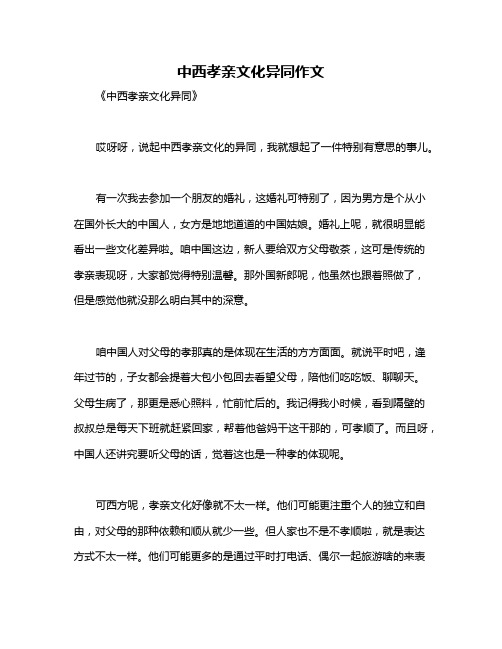
中西孝亲文化异同作文《中西孝亲文化异同》哎呀呀,说起中西孝亲文化的异同,我就想起了一件特别有意思的事儿。
有一次我去参加一个朋友的婚礼,这婚礼可特别了,因为男方是个从小在国外长大的中国人,女方是地地道道的中国姑娘。
婚礼上呢,就很明显能看出一些文化差异啦。
咱中国这边,新人要给双方父母敬茶,这可是传统的孝亲表现呀,大家都觉得特别温馨。
那外国新郎呢,他虽然也跟着照做了,但是感觉他就没那么明白其中的深意。
咱中国人对父母的孝那真的是体现在生活的方方面面。
就说平时吧,逢年过节的,子女都会提着大包小包回去看望父母,陪他们吃吃饭、聊聊天。
父母生病了,那更是悉心照料,忙前忙后的。
我记得我小时候,看到隔壁的叔叔总是每天下班就赶紧回家,帮着他爸妈干这干那的,可孝顺了。
而且呀,中国人还讲究要听父母的话,觉着这也是一种孝的体现呢。
可西方呢,孝亲文化好像就不太一样。
他们可能更注重个人的独立和自由,对父母的那种依赖和顺从就少一些。
但人家也不是不孝顺啦,就是表达方式不太一样。
他们可能更多的是通过平时打电话、偶尔一起旅游啥的来表达对父母的爱和关心。
我有个远房亲戚在国外,他就经常给家里打电话,聊聊自己最近的生活,还会给父母寄一些小礼物呢。
不管是中国的孝亲文化还是西方的孝亲文化,其实都是对父母的爱呀,只是形式不同罢了。
就像那个婚礼上的新郎,虽然开始不太适应咱中国的敬茶仪式,但他对女方父母也是很尊重和关心的呢。
反正我觉得吧,不管是哪种孝亲文化,都有它的美好之处。
咱可以互相学习,让我们对父母的爱更加丰富多彩。
嘿嘿,这就是我对中西孝亲文化异同的一点小感受啦,大家看看是不是这么回事呀!。
中西方孝文化对比研究

2014年10月总第330期摘要:本文对中西方的孝文化进行对比,认为其有较大的差异。
中国孝文化博大精深,源远流长;而西方孝文化却鲜有发展。
这均取决于中西方较大的文化差异。
关键词:中西对比;孝文化;文化差异一、引言舜,传说中的远古帝王,五帝之一,姓姚,名重华,号有虞氏,史称虞舜。
相传他的父亲瞽叟及继母、异母弟象,多次想害死他:让舜修补谷仓仓顶时,从谷仓下纵火,舜手持两个斗笠跳下逃脱;让舜掘井时,瞽叟与象却下土填井,舜掘地道逃脱。
事后舜毫不嫉恨,仍对父母恭顺,对弟弟慈爱。
他的孝行感动了天帝。
舜在历山耕种,大象替他耕地,鸟代他锄草。
帝尧听说舜非常孝顺,有处理政事的才干,把两个女儿娥皇和女英嫁给他;经过多年观察和考验,选定舜做他的继承人。
舜登天子位后,去看望父亲,仍然恭恭敬敬,并封象为诸侯。
这个故事出自于《二十四孝》中的第一孝“孝感动天”。
以孝道伦理为核心内容的孝文化是中国传统文化的一项很重要的内容。
在其数千年的发展演变中,孝成为中国人立身、处世的基本准则之一,也成为封建统治者治国安邦的重要方略。
作为一种道德意识和价值理想,孝是中国古代家庭、社会、国家的精神基础,对中国传统政治、文化、教育及法律观念、国民性格等产生了重要影响,对中国传统社会的和谐稳定发挥了重要的作用。
二、中西方孝文化对比1.中国孝文化为了对中西方孝文化的不同有更进一步的了解,我们首先对中国孝文化进行剖析。
孝是中华民族的传统美德,孝文化是中国传统文化最突出的特色。
我国的孝观念形成于父系氏族公社时代,孝文化在殷商时期便已产生。
殷墟的甲骨文里,就有了“孝”字。
汉字的“孝”,剖其字形上半部为老,下半部为子,形象地表示为上辈的父母应该抚养下辈的子女,下辈的子女则要孝敬上辈的父母。
我国古代的经典里,关于孝的论述比比皆是。
如:我国最早的诗歌总集《诗经》中有“哀哀父母,生我劬劳”。
集中国传统文化之大成的儒家经典代表《论语》中的“入则孝,出则悌,谨而言,泛爱众,而亲仁”等,至今仍有很强的现实意义。
矿产
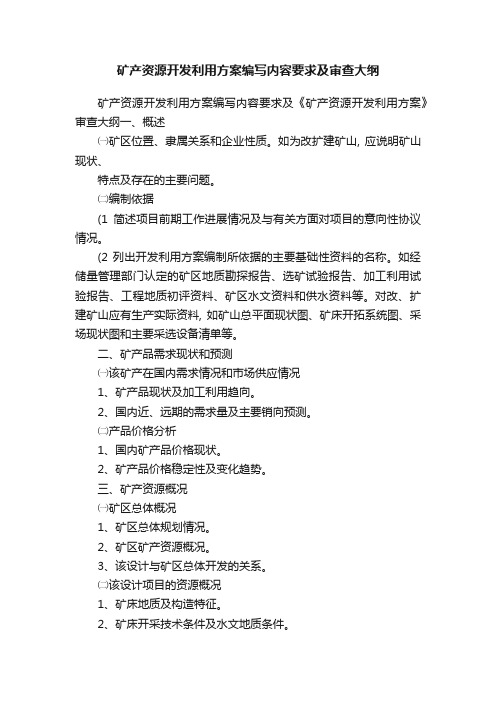
矿产资源开发利用方案编写内容要求及审查大纲
矿产资源开发利用方案编写内容要求及《矿产资源开发利用方案》审查大纲一、概述
㈠矿区位置、隶属关系和企业性质。
如为改扩建矿山, 应说明矿山现状、
特点及存在的主要问题。
㈡编制依据
(1简述项目前期工作进展情况及与有关方面对项目的意向性协议情况。
(2 列出开发利用方案编制所依据的主要基础性资料的名称。
如经储量管理部门认定的矿区地质勘探报告、选矿试验报告、加工利用试验报告、工程地质初评资料、矿区水文资料和供水资料等。
对改、扩建矿山应有生产实际资料, 如矿山总平面现状图、矿床开拓系统图、采场现状图和主要采选设备清单等。
二、矿产品需求现状和预测
㈠该矿产在国内需求情况和市场供应情况
1、矿产品现状及加工利用趋向。
2、国内近、远期的需求量及主要销向预测。
㈡产品价格分析
1、国内矿产品价格现状。
2、矿产品价格稳定性及变化趋势。
三、矿产资源概况
㈠矿区总体概况
1、矿区总体规划情况。
2、矿区矿产资源概况。
3、该设计与矿区总体开发的关系。
㈡该设计项目的资源概况
1、矿床地质及构造特征。
2、矿床开采技术条件及水文地质条件。
- 1、下载文档前请自行甄别文档内容的完整性,平台不提供额外的编辑、内容补充、找答案等附加服务。
- 2、"仅部分预览"的文档,不可在线预览部分如存在完整性等问题,可反馈申请退款(可完整预览的文档不适用该条件!)。
- 3、如文档侵犯您的权益,请联系客服反馈,我们会尽快为您处理(人工客服工作时间:9:00-18:30)。
矿产资源开发利用方案编写内容要求及审查大纲
矿产资源开发利用方案编写内容要求及《矿产资源开发利用方案》审查大纲一、概述
㈠矿区位置、隶属关系和企业性质。
如为改扩建矿山, 应说明矿山现状、
特点及存在的主要问题。
㈡编制依据
(1简述项目前期工作进展情况及与有关方面对项目的意向性协议情况。
(2 列出开发利用方案编制所依据的主要基础性资料的名称。
如经储量管理部门认定的矿区地质勘探报告、选矿试验报告、加工利用试验报告、工程地质初评资料、矿区水文资料和供水资料等。
对改、扩建矿山应有生产实际资料, 如矿山总平面现状图、矿床开拓系统图、采场现状图和主要采选设备清单等。
二、矿产品需求现状和预测
㈠该矿产在国内需求情况和市场供应情况
1、矿产品现状及加工利用趋向。
2、国内近、远期的需求量及主要销向预测。
㈡产品价格分析
1、国内矿产品价格现状。
2、矿产品价格稳定性及变化趋势。
三、矿产资源概况
㈠矿区总体概况
1、矿区总体规划情况。
2、矿区矿产资源概况。
3、该设计与矿区总体开发的关系。
㈡该设计项目的资源概况
1、矿床地质及构造特征。
2、矿床开采技术条件及水文地质条件。
